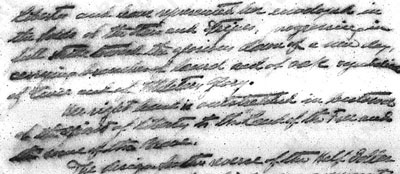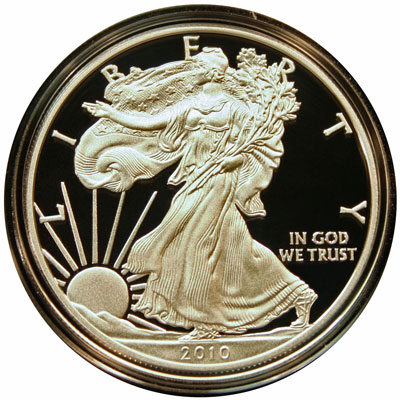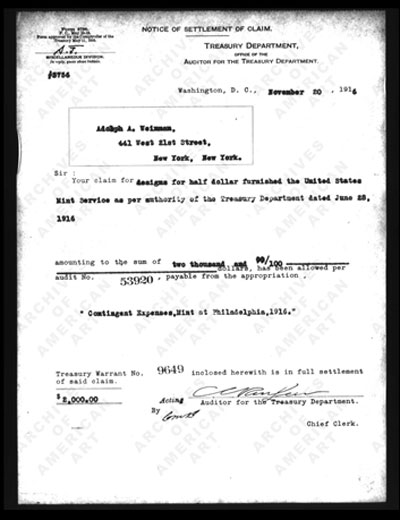Back in 1916, Adolph Alexander Weinman, along with two other artists, submitted designs for new coinage at the request of the US Mint. The artists worked on the obverse and reverse designs for the new dime, quarter and half dollar coins.
On February 23, 1916, Mr. Woolley, Director of the Mint, composed a letter to Mr. Weinman with the following message:
“It gives me pleasure to notify you informally that your models have been accepted for the half dollar and the dime, and that one of the eagles submitted by you is to be used on the reverse of the quarter. In other words, the Secretary of the Treasury and I have awarded you tentatively two and one half out of a possible three designs. One of Mr. MacNeil’s models has been selected for the obverse of the quarter dollar. “
After including comments about returning the models, the Director added, “Of course the contents of this letter are to be treated as confidential until such time as the Secretary of the Treasury and the Director of the Mint decide to make the awards public.”
Over the next few months, Mr. Weinman spent more time on the models for the coins. In May, the Mint requested he provide details of his thoughts behind the symbolism and imagery in his designs.
On May 23, 1916, Mr. Weinman sent a handwritten letter describing his work.
In it he included:
“In my design for the half dollar, I have decided on a full length female figure of Liberty and have represented her enveloped in the folds of the Stars and Stripes, progressing in full stride toward the glorious dawn of a new day, carrying branches of laurel and of oak symbolical of civil and of military glory.
Her right hand is outstretched in bestowal of the spirit of liberty to the land of the free and the home of the brave.
The design for the reverse of the half dollar shows an eagle perched high upon a mountain crag, his wings unfolded, fearless in spirit and conscious of his power.
Springing from a rift in the rock is a sapling of mountain pine, symbolical of America.”
(He was not only a sculptural artist, but his artistry also showed in his words.)
Just a few days later, another letter, composed at the Mint on May 29, 1916, arrived with the following:
“It gives me pleasure to notify you formally that the designs submitted by you for the proposed new Half Dollar and Dime have been accepted, and are hereby approved.”
The Director of the Mint, R.W. Woolley, signed the letter which also included an approval signature by Secretary of the Treasury, W.G. McAdoo.
(Note that the formal letter no longer mentioned the eagle reverse on the quarter whose design was awarded to Mr. MacNeil.)
Toward the end of the year, the dies had been completed and the coins were being minted with quantity deliveries scheduled for early January 1917.
But, the newspaper reporters of the day had seen the new coins and provided positive commentary on the designs. Though we can see some of Mr. Weinman’s description in their articles as evidenced by the Tribune of New York City. They included the following about the half dollar on December 27, 1916:
“No one familiar with the usual variety of half dollar would recognize the new one. A full length figure of Liberty advancing in the breeze appears on the obverse. The folds of her garment are the Stars and Stripes which flutter in the background as she progresses with a full stride toward the dawn of a new day. She is carrying branches of laurel and oak, the symbols of civil and military glory. Her hand is outstretched in bestowal of the spirit of liberty on all nations.
On the reverse a new type of eagle is found. He stands high on a mountain crag, wings unfolded, fearless in spirit and consciousness of power. From a rift in the mountain springs a sapling of mountain pine, the symbol of the early American spirit.
The half dollar was designed by Adolph A. Weinman, who was also designer of the new dime, recently issued.”
His half dollar design became known as the Walking Liberty Half Dollar and is recognized by many as the most beautiful coin to come from the US Mint. As a result, his design was resurrected for the American Silver Eagles we enjoy today.
Here’s the 2010 version – isn’t she still gorgeous almost 100 years later?
The information above is courtesy of the Adolph A. Weinman papers, 1890-1959, Archives of American Art, Smithsonian Institution.
Specifically, you can find the details at the following links:
Informal award of coin designs see frame #1151
Weinman letter describing symbolism of coin designs see frames #482-485
Formal letter of coin design award see frame #1156
Tribune December 27, 1916 Newspaper article see frame #1168
One last interesting item about the Walking Liberty Half Dollar design, Mr. Weinman was paid $2000.
Payment voucher see frame #1164
Two thousand of today’s dollars will buy a few, if you can find them, of the American Silver Eagles with Mr. Weinman’s beautiful Liberty walking into the “glorious dawn of a new day.”


